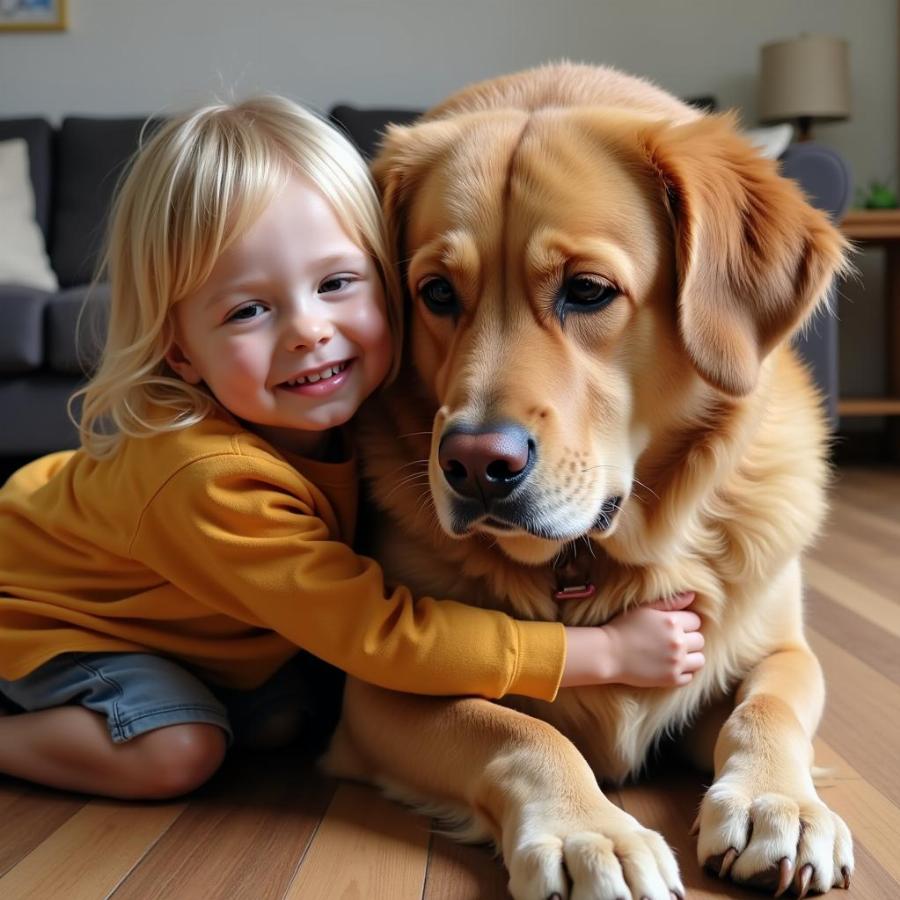The term “big dog” goes beyond mere physical size. While it certainly conjures images of imposing breeds like Great Danes or Mastiffs, it also carries a deeper, more symbolic meaning. Understanding what “big dog” truly represents involves exploring both the literal and figurative aspects, encompassing everything from breed characteristics and responsibilities of ownership to the societal perceptions and cultural impact these majestic canines have on our lives.
Decoding “Big Dog”: Size and Beyond
When we say “big dog,” the most obvious interpretation relates to physical stature. We’re talking about breeds that command attention with their impressive height and weight. Think of a white german shepherd dog standing tall and proud, or a Bernese Mountain Dog with its thick, luxurious coat. But “big dog” also implies a certain presence, a confidence that transcends mere inches and pounds. It speaks to a dog’s temperament, its role within a pack, and even its perceived status within a family or community.
What Defines a Big Dog Breed?
Generally, breeds weighing over 50 pounds are considered large, and those exceeding 100 pounds fall into the giant category. This distinction is important because size often correlates with specific needs and considerations for owners. Larger breeds require more space, more food, and often more specialized training. Their sheer strength necessitates responsible handling and a deep understanding of their breed-specific traits.
The Responsibilities of Owning a Big Dog
Owning a big dog is a rewarding experience, but it’s also a significant commitment. These gentle giants require more than just food and water; they thrive on companionship, mental stimulation, and plenty of exercise. Consider the space they need to move around comfortably, both indoors and outdoors. Think about the cost of feeding a large breed, as well as potential vet bills, which can be higher for bigger dogs.
Big Dogs, Big Hearts, Big Needs
Big dogs often have equally big hearts, craving affection and connection with their human families. They can be incredibly loyal and protective, making them wonderful companions. However, their size and strength mean that proper training is essential, not only for their well-being but also for the safety of others. Socialization from a young age is crucial to ensure they interact appropriately with other dogs and people.
“Big Dog” in a Figurative Sense
Beyond the literal interpretation, “big dog” also holds symbolic meaning. It often refers to someone powerful, influential, or dominant in a particular field. In business, the “big dogs” might be the CEOs or industry leaders. In sports, it could be the star athletes or championship teams. This figurative use of the term borrows from the image of a large, powerful canine, associating size and strength with status and authority.
The Cultural Impact of Big Dogs
Big dogs have played a significant role in human history and culture, serving as working dogs, guardians, and cherished companions. They appear in art, literature, and film, often symbolizing loyalty, courage, and even nobility. Think of the iconic image of a Saint Bernard with a brandy barrel around its neck, rescuing travelers lost in the snow. These powerful portrayals contribute to our understanding of “big dog” as something more than just a physical description.
What Does Owning a Big Dog Mean to You?
Ultimately, the meaning of “big dog” is personal and multifaceted. It’s about understanding the unique needs and responsibilities that come with caring for a large breed, appreciating their remarkable qualities, and recognizing the symbolic weight they carry in our culture. Whether you’re drawn to their imposing size, their gentle nature, or the sense of security they provide, owning a big dog is a deeply enriching experience.
 Big Dog Companionship
Big Dog Companionship
FAQ: Understanding Big Dogs
-
What are some common health issues in big dogs? Hip dysplasia, bloat, and certain types of cancer are more prevalent in larger breeds.
-
How much exercise does a big dog need? Big dogs typically require at least an hour of exercise daily, though this can vary by breed and individual needs.
-
Is it more expensive to own a big dog? Yes, generally, due to higher food costs, larger doses of medication, and potentially more specialized veterinary care.
-
Are big dogs suitable for apartment living? Some big dogs can adapt to apartment life if they get sufficient exercise and mental stimulation, but it’s essential to choose a breed with a temperament suited to a smaller space.
-
What’s the best way to train a big dog? Positive reinforcement methods are generally the most effective, focusing on rewarding desired behaviors rather than punishing unwanted ones.
-
Are big dogs more aggressive? Not necessarily. A dog’s temperament is more influenced by breed, socialization, and individual personality than by size alone.
-
Where can I find reputable breeders of big dog breeds? Research breed-specific rescue organizations and contact national breed clubs for referrals to responsible breeders.
Further Exploration on Beaut Dogs
For more insights into specific big dog breeds, training tips, and care advice, explore these related articles on Beaut Dogs: hippie dog names and dog fish images.
Beaut Dogs is your go-to resource for all things canine, offering expert advice and valuable information for dog lovers everywhere. From breed profiles to health tips, we’re dedicated to helping you provide the best possible care for your furry friend. For personalized assistance and answers to your specific questions, contact us via Email at [email protected]. We’re here to support you on your journey as a responsible and loving dog owner.